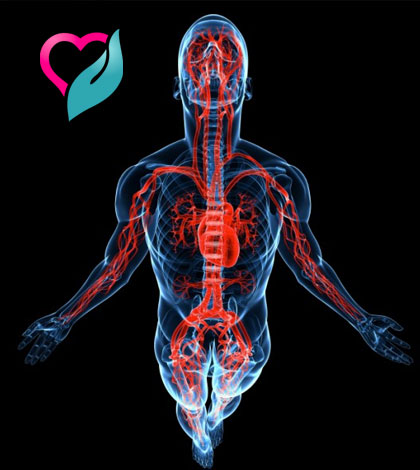Blood circulation problems arise when there is limited blood flow to the legs, hands, heart, and rest of the body, including the fingers, toes and feet.
[wp_ad_camp_1]
The blood vessels become blocked as a fatty substance called plaque builds up and hardens and constricts the walls of the arteries and veins. This interrupts the normal flow of blood through the vessels and results in poor circulation.
A variety of conditions can be brought on by poor circulation such as high blood pressure, hypertension, stroke, varicose veins, peripheral artery disease, heart disease, kidney damage, aneurysms, arteriosclerosis, Raynaud’s disease, and phlebitis.
Poor Circulation in Babies
Since the heart is the primary organ in the circulatory system, responsible for pulmonary and systemic functioning, infants born with complex congenital heart defects are especially prone to experiencing difficulties. Any defect in the normal blood flow can have a significant impact on a child’s physical and mental development, from growth to behavioral and academic performance.
[wp_ad_camp_4]
Poor Circulation during Pregnancy
Many women experience circulation changes during the second and third trimesters, which tend to affect the legs and result in cramping. This is likely attributed to the added weight of the baby and subsequent stress of the leg muscles. Consult your doctor if you experience sudden redness, swelling, or warmth.
Stretching the legs before bed or before a long period of sitting such as on a plane can help ease common stiffness that leads to cramping. Try not to stay in one position for too long; get up to move around whenever possible. Regular exercise, including mild walking, can also help keep the blood flowing.
General Effects of Poor Blood Circulation
- Brain – Poor blood circulation can impact the brain causing fatigue, dizziness, memory loss, and frequent and unexplained headaches.
- Heart – Poor blood circulation can have an impact on the heart, causing inability to perform simple aerobic activities like climbing stairs without breathlessness; high blood pressure and cholesterol, and chest pain can be other symptoms. Heart attack and stroke are major risks of poor circulation that remains untreated.
- Liver – Symptoms of poor blood circulation in the liver can include lack of appetite or unexplained weight loss, and changes in skin tone.
- Kidneys – Poor circulation to the kidneys are typically the result when there is swelling of the hands, feet and ankles. Other symptoms can include fatigue, altered heart rate and rise in blood pressure.
- Limbs – With poor circulation, cramps in the limbs, numbness and varicose veins can appear as symptoms.
[wp_ad_camp_2]
Symptoms
Symptoms and signs of poor circulation may include numbness or loss of sensation or tingling in the hands, feet, or toes; changes in skin temperature (cold hands, feet, legs, and ears); fatigue (lack of or low energy); hair loss; vertigo or dizziness; dry skin; edema or swelling in the feet, legs and/or fingers; varicose veins, leg ulcers and foot ulcers; headaches; irregular heart beats; sluggish memory; lack of stamina, etc.
Causes
Circulatory system problems can be caused by certain medical conditions, lifestyle factors and behaviors. Other factors that contribute to circulatory system problems are tobacco smoking, alcohol consumption, caffeine, poor eating habits, insufficient exercise and sitting in a cramped position or no movement for long periods (also known as economy class syndrome/DVT – deep vein thrombosis).
Treatment for Poor Circulation
Circulatory system problems can be treated with conventional medication, lifestyle changes as well as natural and alternative therapies. The primary objective is to prevent circulatory problems, relieve swelling, pain and speed healing. Mild cases of bad circulation usually require an aerobic exercise program, a healthy eating plan and a low dose of aspirin. In addition to these treatment options, you would also have to revise your nutritional requirements by increasing your intake of water and eliminating refined foods such as caffeine, alcohol and sugar. Include low fat and high fiber in your diet to reduce cholesterol levels and improve circulation.
Natural Remedies
Foods to Improve Circulation
- Fruits and vegetables of any kind are good for your health, particularly oranges, which provide high levels of bioflavonoids to promote blood flow while also strengthening capillaries, as well as watermelon, a natural source of lycopene, which has been known to help prevent plaque buildup, a common hindrance to blood flow, to help promote healthy circulation.
- Nuts are rich in vitamin B3, which helps boost the blood.
- Garlic also helps promote circulation.
- Consider taking some omega 3 fish oils. This can be as a supplement or you can add more oily fish to your diet.
Regular physical activity is a great way to help improve circulation. If you are not already active, consult with your doctor first before starting any new program. Most people can begin with mild exercise and gradually advance to more rigorous activity. Walking, swimming, and biking are all good to get the blood pumping.
If you smoke, then quit! If you are serious about improving your health then you just can't smoke.
Use hot and cold treatment. This involves putting the affected body part in the warmth and then alternating it with something colder. This could be a bowl of warm water and a different bowl of colder water.
You can also try some relaxation techniques such as a little meditation or listening to music. This can be very soothing and can really lift your spirits and reduce stress levels.
Massaging, as many of us tend to perceive is an act of relaxation, but it is more than that. The touch of hands and legs in appropriate places calms your muscles and joints, relieves stress as well as improves blood circulation which helps the body in many ways.
[wp_ad_camp_3]
Image courtesy: brainbodyperformance.com , dailyrecord.co.uk , health.india.com





























